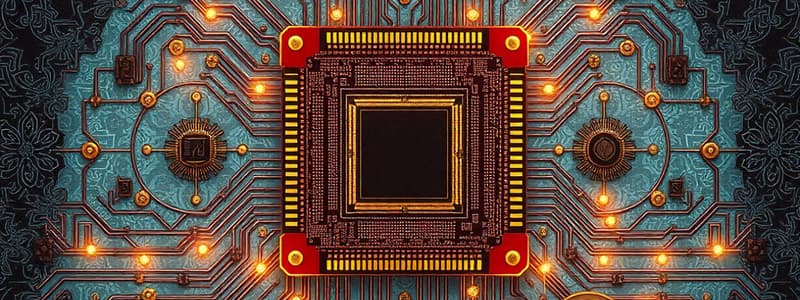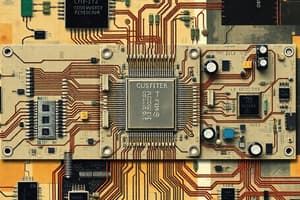Podcast
Questions and Answers
What is a microprocessor?
What is a microprocessor?
An electronic chip that functions as the central processing unit (CPU) of a computer.
What is a microcontroller?
What is a microcontroller?
A microprocessor chip with built-in hardware for memory and ports.
Which of the following options classify microprocessors based on their specifications?
Which of the following options classify microprocessors based on their specifications?
- General-purpose processors
- Microcontrollers
- Special-purpose processors
- All of the above (correct)
What are the two forms in which instruction sets for microprocessors are generally presented?
What are the two forms in which instruction sets for microprocessors are generally presented?
Which semiconductor manufacturing technology is favored for portable computers and battery-powered devices?
Which semiconductor manufacturing technology is favored for portable computers and battery-powered devices?
Which type of processor architecture supports a limited set of machine language instructions?
Which type of processor architecture supports a limited set of machine language instructions?
CISC processors are less expensive than RISC processors.
CISC processors are less expensive than RISC processors.
Match the following types of microprocessors with their characteristics:
Match the following types of microprocessors with their characteristics:
Flashcards are hidden until you start studying
Study Notes
Introduction to Microprocessors
- A microprocessor is an electronic chip that serves as the CPU of a computer, acting as the "brain" of the system.
- Found in various consumer electronics, such as printers, washing machines, microwaves, mobile phones, and advanced systems like radars and satellites.
- Basic microprocessors include arithmetic and logic units along with control logic for executing instructions.
- Operate on the principle of stored-program execution: instructions are stored sequentially in memory and fetched one by one for processing.
Programming and Instruction Sets
- Programming is essential for microprocessors to perform tasks; without a program, the microprocessor is non-functional.
- Programmers must understand the microprocessor's resources and instruction sets provided by manufacturers.
- Instruction sets include mnemonics (easier for humans to understand) and binary machine code (used by the microprocessor).
- Programs are typically written in assembly-level language and converted to machine-level language.
Input and Interfacing
- Microprocessor-based systems require input interfacing circuits and ports to handle various forms of data.
- Semiconductor manufacturing technologies for microprocessors have evolved from TTL (Transistor-Transistor Logic) to CMOS (Complementary Metal-Oxide-Semiconductor) and ECL (Emitter-Coupled Logic).
- CMOS technology is favored for portable devices due to its low power consumption.
Classification of Microprocessors
- Microprocessors can be classified based on specifications, applications, and architecture.
Based on Data Size
- General-purpose processors: Used for a wide range of applications (e.g., Intel 8085, Intel Pentium).
- Microcontrollers: Microprocessors with built-in memory and ports, suitable for generic control applications.
- Special-purpose processors: Designed for specific functions, such as Digital Signal Processors (DSPs), which have special instructions for signal processing.
Based on Architecture
- RISC (Reduced Instruction Set Computing): Supports a limited set of machine language instructions and executes programs faster than CISC processors.
- CISC (Complex Instruction Set Computing): More expensive than RISC, offers a broader set of instructions.
- VLIW (Very Long Instruction Word): Executes multiple machine operations in parallel, optimizing instruction-level parallelism.
- Superscalar processors: Utilize complex hardware for overlapping instruction execution, increasing processing speed.
Studying That Suits You
Use AI to generate personalized quizzes and flashcards to suit your learning preferences.




